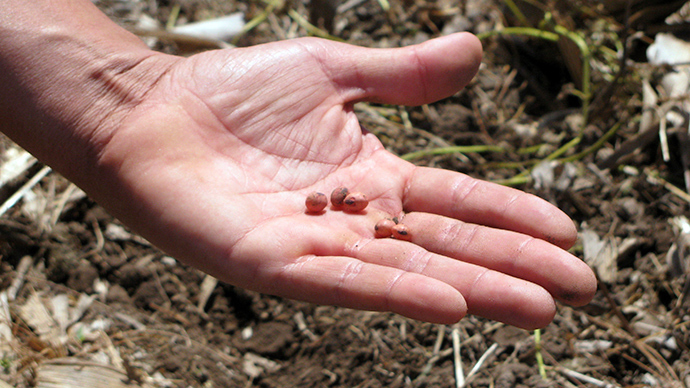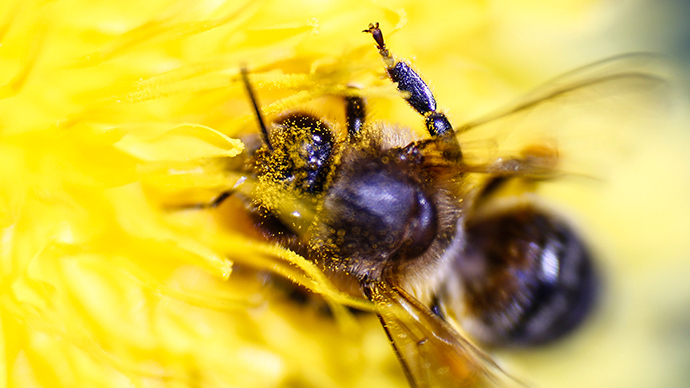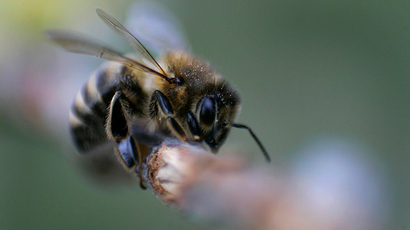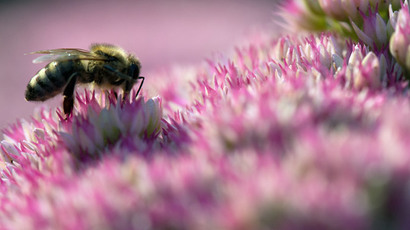‘Bee killer’ pesticide provides little benefit to farmers - EPA

The Environmental Protection Agency has confirmed that a popular class of insecticide used to treat soybean seeds provides little or no benefit to the farmers – the pesticide, however, is the prime suspect for the deaths of 30 million honeybees.
The EPA’s Biological and Economic Analysis Division (BEAD) made its conclusion after analyzing 26 published studies on the pesticide-treated soybean seeds and studying yields over a four-year period. They found no difference in soybean yield when using the treated seed, and it did not protect the bean any better than if there was no pest control.
.@EPA : neonics deliver ittle or no benefits to soybeans, on which they're widely used. Who's gonna break it to bees? http://t.co/sBstlf7ixb
— Tom Philpott (@tomphilpott) October 17, 2014
The class of insecticides in question are called neonicotinoids,
which work on insects by damaging their central nervous systems,
causing tremors, paralysis, and death. The insecticide is
absorbed into treated plants and distributed in their vascular
systems, rendering various parts – including the roots, leaves,
stem, flowers, nectar, pollen, and guttation fluid – toxic to
insects.
Soybeans are planted on 76 million acres in the US – the majority
in the Corn Belt (Illinois, Indiana, Iowa, Missouri and Ohio),
and Northern Plains (Kansas, Nebraska, North and South Dakota).
The average value of the soybean yield is $38 billion per annum.
READ MORE:EPA does not have to address call to mandate labeling of hazardous pesticide ingredients - judge
The agency found the neonicotinoid-treated seeds were applied to
30 percent of soybean acres while the remaining crop land
received a seed treatment of another type of insecticide,
funigicide or nematicide. The agency concluded the neonicotinoid
seeds are only active in the first 3-4 weeks of planting which
doesn’t coincide with typical periods of a pest activity. The
chemical’s main target is the Soybean aphid, which are general
active later in the growing season.
Prior to 2004, the EPA said only 430,000 pounds of the
neonicotinoid-infused seeds were used, but 2008-2013, one million
pounds of treated seeds have been bought and used.
“Given that much of the reported seed treatment usage in the
US on soybeans is not associated with a target pest, BEAD
concludes that much of the observed use is preventative and may
not be currently providing any actual pest management
benefit,” reported the EPA.
Hi, I'm #bumblebee, been here 30 million yrs. I'd like to stick around longer but unlikely without #neonicotinoid ban pic.twitter.com/qOGtmGDkng
— Brigit Strawbridge (@B_Strawbridge) October 16, 2014
The EPA also found that farmers said untreated seeds were either
difficult to obtain or not available.
“EPA's fundamental purpose is to protect the environment and
so far they've been protecting the bottom line of chemical
companies who have sold farmers a bill of goods” said
Larissa Walker, pollinator campaign director at Center for Food
Safety (CFS), on the organization’s website. “Maybe this new
evidence will be enough to compel meaningful action that’s long
overdue.”
At most, the agency found these seeds could provide insurance
against sporadic or unpredictable pests, particularly in the
southern United States. However, there was no real world
experience detailing when that had happened, and if it occurred
it wouldn’t be widespread.
Peter Jenkins, the CFS attorney spearheading a lawsuit against
the EPA over neonicotinoids, said, “It is abundantly clear
that the costs of neonicotinoids outweigh the benefits, and there
is no excuse for the agency to continue to allow such
indiscriminate use.”
In its report, the EPA makes no mention of the effect of
neonciotinoids on other insects other than the ones targeted by
the chemical companies like aphids, but the CFS did in their
report released in March 2014.

In that survey, the CFS linked the use of this insecticide to the
dramatic downturn in the honeybee population.
“Neonicotinoids are a class of pesticides known to have acute
and chronic effects on honey bees and other pollinator species
and are considered a major factor in colony collapse,” it
read. “Neonicotinoid pesticides are also slow to break down,
causing them to build up in environments where they are applied.
They contaminate surface water, ground water, and soil,
endangering not only pollinators, but also other beneficial
species that inhabit these ecosystems.”
READ MORE:Chemical producer lobbies for increase in allowed levels of pesticide linked to 'Beemageddon'
The US Department of Agriculture (USDA) has estimated that 10 million bee hives have been lost since 2006, representing a two-billion-dollar cost to beekeepers. The USDA estimates pollinator services to be worth $20-30 billion annually.
Scary infographic: only 5% of neo-nicotinoids end up on the crop. Approx 94% in soil and water pic.twitter.com/mZTOtzWZnU via @DaveGoulson
— Rebecca Lave (@RebeccaLave) July 14, 2014
In its report, the EPA also included highlights from a 2014
survey by the North Central IPM Center which polled researchers
who had been studying the seed treatments. Out of 37 completed
questionnaires, 74 percent of researchers said that soybean
yields either stayed the same or decreased. When asked about the
application of foliar pesticide applications, 100 percent of
respondents said the sprays (both aerial and ground) either
stayed the same or actually increased.
“Chemical companies have been charging higher costs for
coated seeds that have failed to deliver benefits. Meanwhile,
society at large continues to suffer the economic and
environmental consequences of overusing neonicotinoids,”
added Walker.
READ MORE: Bee studies feel sting of pesticide manufacturers – MPs
In July 2014, the US Fish and Wildlife Service (FWS) announced it will phase out neonicotinoid insecticides in all wildlife refuges nationwide by January 2016, according to CFS.














